<
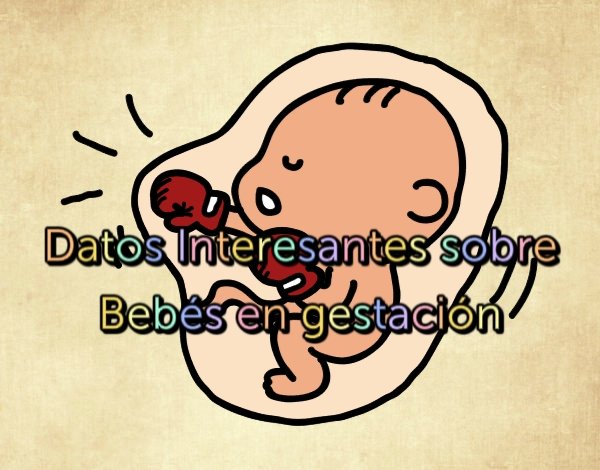
Hola colmena, el día de hoy quise mostrarles un post sobre datos muy interesantes, por esta razón he seleccionado un tema muy hermoso, como lo es este, Los bebés en el vientre materno. Comencemos:
Hello hive, today I wanted to show you a post about very interesting facts, for this reason I have selected a very beautiful topic, such as this one, Babies in the womb. Let's get started:
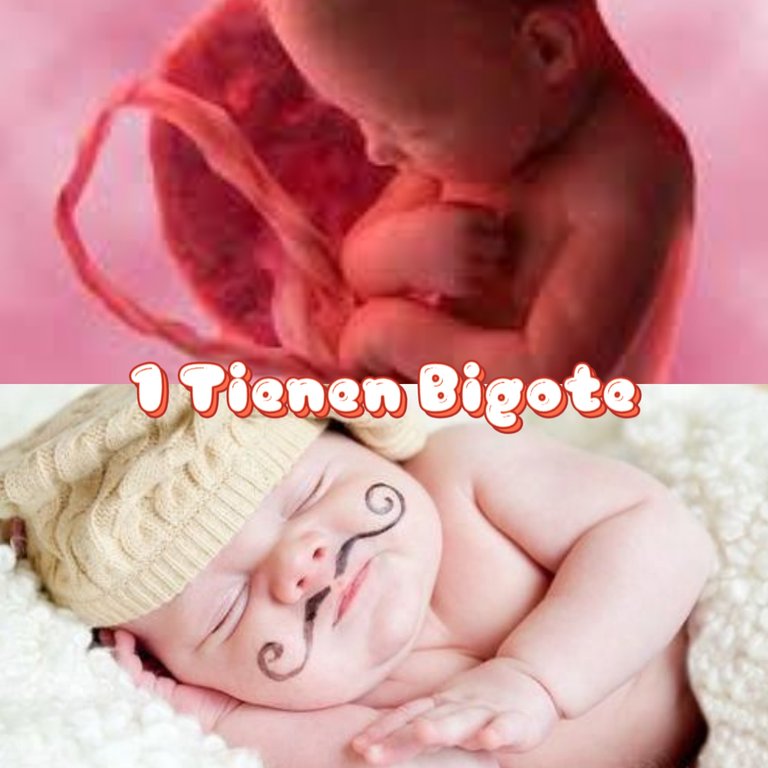
Se llama lanugo. Es una especie de vello muy fino, como un terciopelo, que a partir de la semana 15 recubrirá todo el cuerpo.
Sale en la cabeza, y en algunas partes de la cara. Desaparecerá poco antes de nacer y entonces aparecerá el vello definitivo. También los elefantes, las ballenas y las focas tienen lanugo, al igual que los primates. Pero únicamente al ser humano se le cae antes de nacer: el resto lo conservará siempre.
"They have a mustache"
It's called lanugo. It is a kind of very fine hair, like velvet, which from week 15 will cover the entire body. It comes out on the head, and in some parts of the face. It will disappear shortly before birth and then the definitive hair will appear. Elephants, whales, and seals also have lanugo, as do primates. But only to the human being it falls before being born: the rest will always keep it.

Aunque estén en el líquido amniótico, es como si nadaran en una piscina y fueran abriendo los ojos. Ocurre en las semanas 12-14. También empezarán a tocarse la cara , y a meter los dedos en la boca
"They open and close their eyes" Although they are in the amniotic fluid, it is as if they were swimming in a pool and opening their eyes. It occurs in weeks 12-14. They will also begin to touch their faces, and put their fingers in their mouths.
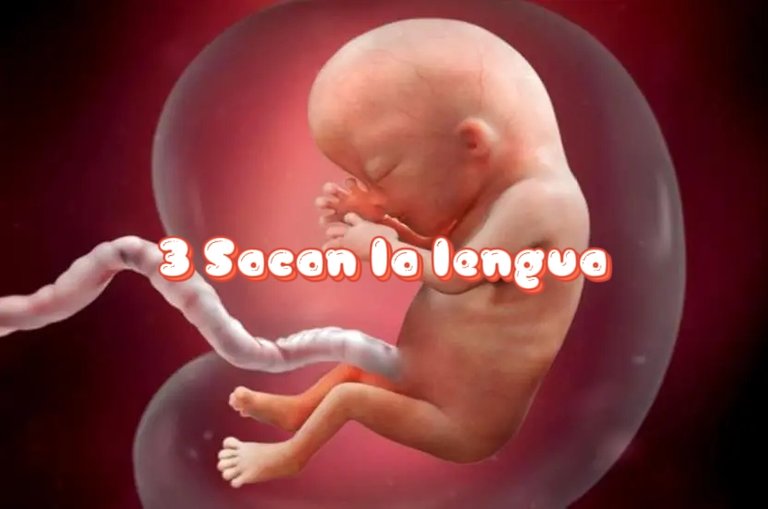
También ocurre por primera vez en la semana 13. Así que en una ecografía puede parecer que se burle
Los fetos responden abriendo la boca y sacando la lengua a estímulos musicales emitidos desde la vagina de la madre con tan sólo 16 semanas de gestación
"They stick out their tongues"
It also occurs for the first time at week 13. So on an ultrasound it may appear to be teasing Fetuses respond by opening their mouths and sticking out their tongues to musical stimuli emitted from the mother's vagina at only 16 weeks of gestation
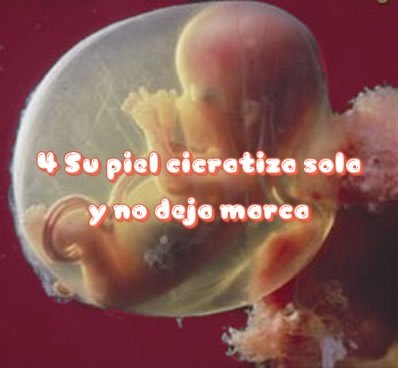
Las heridas fetales durante los dos primeros trimestres de la gestación se reparan rápidamente y sin formación de cicatrices. La cicatrización de heridas es un proceso complejo y estrictamente regulado que se divide en cuatro etapas superpuestas: coagulación, inflamación, proliferación y maduración. Durante la fase inflamatoria aguda, las células progenitoras circulantes migran al tejido lesionado. Se produce una rápida proliferación celular, que finalmente da como resultado la formación de nuevos vasos sanguíneos y tejido de granulación
La piel de un no nacido es muy especial. Si hubiera que intervenir quirúrgicamente, pinchar o poner un catéter al feto, esto sería lo que menos preocuparía al médico porque sabe que la herida cerraría sola y, además, no dejaría cicatriz.
"His skin heals quickly and without leaving a mark"
Fetal wounds during the first two trimesters of pregnancy heal quickly and without scar formation. Wound healing is a complex and tightly regulated process that is divided into four overlapping stages: coagulation, inflammation, proliferation, and maturation. During the acute inflammatory phase, circulating progenitor cells migrate into injured tissue. Rapid cell proliferation occurs, ultimately resulting in the formation of new blood vessels and granulation tissue The skin of an unborn is very special. If it were necessary to intervene surgically, puncture or put a catheter in the fetus, this would be the least worrying for the doctor because he knows that the wound would close on its own and, moreover, would not leave a scar.
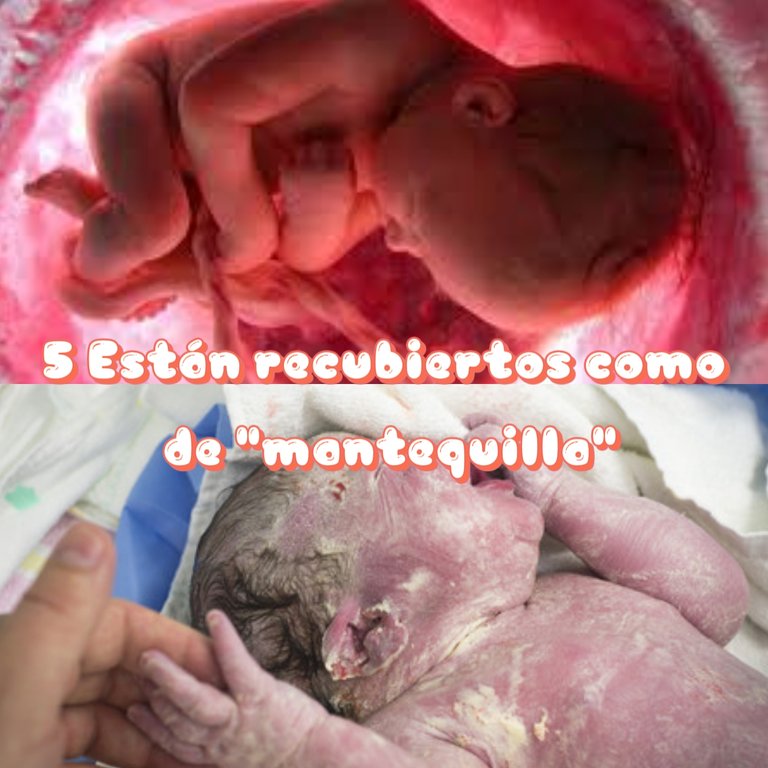
Esta sustancia se llama vérnix caseoso. Es muy suave y su función es protegerme de cara al final del embarazo . Al nacer actuará como una crema hidratante
sobre la piel y ayudará a mantener la temperatura. Después del parto se deja unos días hasta que se elimine por sí sola.
La vérnix caseosa está compuesta por un 80% de agua, un 10% de grasa y otro 10% de proteínas, y es una mezcla de secreciones sebáceas, lanugo y células de la piel descamadas del bebé.
La vérnix caseosa comienza a segregarse entre la semana 18 y 20 de gestación para proteger la delicada piel del bebé de los efectos irritantes del líquido amniótico , impidiendo que se agriete. Su formación coincide con la del estrato córneo, que es el nombre que recibe la capa más externa de la piel. Curiosamente, esta capa solo se puede desarrollar en un ambiente seco, por lo que la vérnix juega un papel fundamental al aislar el líquido amniótico
Su producción disminuye a partir de la semana 36, y desaparece totalmente en la semana 41, de ahí que no todos los bebés nazcan impregnados de esta sustancia, y que sea más visible en bebés prematuros
"They are covered like butter"
This substance is called vernix caseoso. It is very soft and its function is to protect me from the end of pregnancy. At birth it will act as a moisturizer on the skin and will help maintain temperature. After delivery it is left a few days until it is eliminated on its own. Vernix caseosa is made up of 80% water, 10% fat, and another 10% protein, and is a mixture of sebaceous secretions, lanugo and peeling skin cells from the baby. Vernix caseosa begins to secrete between the 18th and 20th week of gestation to protect the baby's delicate skin from the irritating effects of the amniotic fluid, preventing it from cracking. Its formation coincides with that of the stratum corneum, which is the name given to the outermost layer of the skin. Interestingly, this layer can only develop in a dry environment, so the vernix plays a key role in isolating the amniotic fluid. Its production decreases from week 36, and disappears completely at week 41, hence not all babies are born impregnated with this substance, and it is more visible in premature babies
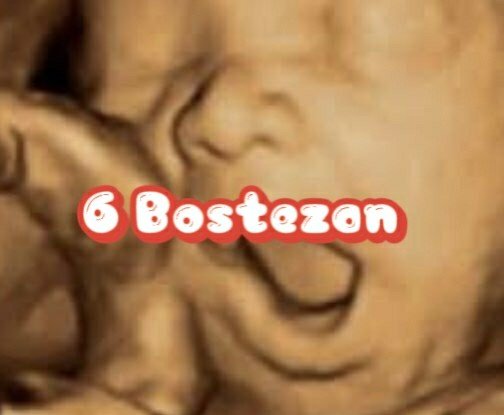
Ya que los bostezos disminuyen según la edad fetal, se trata de un indicador más de desarrollo del bebé. Y como a diferencia de nosotros, los fetos no bostezan por contagio ni por sueño, la frecuencia de los bostezos en el útero puede estar relacionada con la maduración temprana del cerebro en la gestación, el bostezo y la apertura bucal están relacionados con la maduración de la gestación, por ejemplo del sistema nervioso central
"Yawn"
Since yawning decreases according to fetal age, it is one more indicator of the baby's development. And since, unlike us, fetuses do not yawn due to contagion or sleep, the frequency of yawning in the uterus may be related to early maturation of the brain in gestation, yawning and mouth opening are related to maturation of pregnancy, for example of the central nervous system
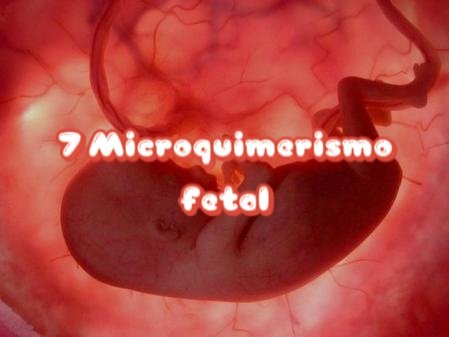
Durante el embarazo se produce una simbiosis increíble entre madre e hijo. Entre otras cosas, comparten sangre y células, unas casi 'mágicas' que provocan lo que se conoce como microquimerismo fetal.
Este fenómeno logra que algunas células madre pluripotenciales de la sangre del feto y la placenta (las que pueden transformarse en cualquier tipo de célula) pasen a la circulación del bebé y a la de la madre, y ayudan a reparar sus órganos.
Las células madre pluripotentes son un tipo de células que aún no han especificado el tipo de célula que serán, por lo que pueden acabar siendo cualquier célula. Así, cuando llegan al cuerpo materno puede transformarse en la célula que haga más falta.
Además, estas células fetales que pasan a la madre tienen una gran capacidad de renovación y colaboran con las células madre adultas en la función regenerativa del cuerpo de la mujer.
Existen estudios que han confirmado la participación de estas células en la reparación del corazón de madres que padecían cardiopatías. Al analizar esas células del corazón se observó que contenían el cromosoma Y, exclusivo del varón, y por lo tanto eran células que provenían del embarazo previo de un niño
"Fetal microchimerism"
During pregnancy there is an incredible symbiosis between mother and child. Among other things, they share blood and cells, some almost 'magical' that cause what is known as fetal microchimerism. This phenomenon allows some pluripotent stem cells from the blood of the fetus and the placenta (which can transform into any type of cell) pass into the circulation of the baby and that of the mother, and help to repair their organs. Pluripotent stem cells are a type of cells that have not yet specified the type of cell they will be, so they can end up being any cell. Thus, when they reach the maternal body, it can be transformed into the cell that is most needed. In addition, these fetal cells that pass to the mother have a great capacity for renewal and collaborate with adult stem cells in the regenerative function of the woman's body. There are studies that have confirmed the participation of these cells in the repair of the heart of mothers suffering from heart disease. When analyzing these cells of the heart it was observed that they contained the Y chromosome, exclusive to the male, and therefore they were cells that came from the previous pregnancy of a child
Cierro el post con una pequeña parte del Salmo 139; 13-16. Donde nos muestra que aún nosotros estando en el vientre de nuestra madre, Dios estuvo con nosotros.
13 Tú creaste mis entrañas;
me formaste en el vientre de mi madre.
14 ¡Te alabo porque soy una creación admirable!
¡Tus obras son maravillosas,
y esto lo sé muy bien!
15 Mis huesos no te fueron desconocidos
cuando en lo más recóndito era yo formado,
cuando en lo más profundo de la tierra
era yo entretejido.
16 Tus ojos vieron mi cuerpo en gestación:
todo estaba ya escrito en tu libro;
todos mis días se estaban diseñando,
aunque no existía uno solo de ellos
I close the post with a small part of Psalm 139; 13-16. Where it shows us that we are still in our mother's womb, God was with us.
13 You created my inward parts; you form me in my mother's womb.
14 I praise you because I am an admirable creation! Your works are wonderful, and this I know very well! 15 My bones were not unknown to you when in the deepest recesses I was formed, when deep in the earth it was me woven together.
16 Your eyes saw my unborn body: everything was already written in your book; all my days were being designed, although there was not a single one of them
Muchas gracias por el tiempo dedicado . Espero les haya gustado. Nos vemos en un próximo post
Thank you very much for your time . I hope you liked it. See you in a next post.
Copyright @stephaniag-All rights reserved
Source of plagiarism 1
Source of plagiarism 2
Source of plagiarism 3
Source of plagiarism 4
Plagiarism is the copying & pasting of others' work without giving credit to the original author or artist. Plagiarized posts are considered fraud and violate the intellectual property rights of the original creator.
Guide: Why and How People Abuse and Plagiarise
Fraud is discouraged by the community and may result in the account being Blacklisted.
If you believe this comment is in error, please contact us in #appeals in Discord.